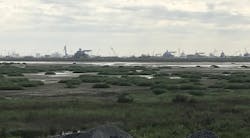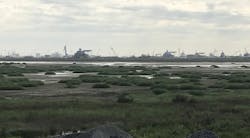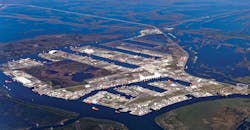Holistic approach to management improves vital services and restores endangered wetlands
Judy Murray, Special Correspondent
According toGreater Lafourche Port Commission Executive Director Chett Chiasson, the efficiencies that exist at Port Fourchon, which services more than 90% of deepwater offshore energy production in the Gulf of Mexico (GoM), exist nowhere else in the world. There is an enormous volume of commodities supplied – liquid mud, pipe, cement, heavy water, and equipment – and a broad range of services.
“If you combine all the other ports in the entire Gulf of Mexico and their capacity to service the oil and gas industry, they are capable of doing about 25% of what Port Fourchon can deliver,” Chiasson said.
Even in challenging market conditions, the port has steadfastly supported exploration and production activities in the GoM.
Weathering the downturn
The drop in oil prices took its toll on Port Fourchon just as it did in other areas of the world where offshore operations generate the majority of demand for services and supplies. Unlike in other areas of the world, however, tenants in Port Fourchon had a partner that understood how burdensome it was for many of them to pay rent.
“Originally, rent prices were tied to the barrel price, but at $60/bbl, it became apparent that the barrel price shouldn’t be the indicator,” Chiasson explained. That realization led to the Port Commission determining rental rates by using the number of assets working in the GoM as the primary consideration, reasoning that it is these drilling rigs that need the commodities provided through the port. “At the peak, there were about 55 rigs working in the Gulf. In January of 2019, there were only about 20,” he said.
The business dynamics are changing, and the “new normal” is particularly impacting vessel operators – many of which call Lafourche Parish home. Utilization rates are low, and these companies are struggling. With oil companies reducing costs, there are fewer vessels under contract, and that is not likely to change very much, Chiasson said.
While industry is important to the port, serving the best interests of the environment is also a big deal to the GLPC. Nearly 100 acres make up the Slip D mitigation area next to the Port Fourchon Operations Center, and plans are in place for more than 40 acres to be added for recreational and educational use in the coming months and years. The lush growth already visible at the site was open water as recently as two years ago. (Photo courtesy Greater Lafourche Port Commission)
In April 2015, the Port Commission made the decision to lower rental rates by 20%, and according to Chiasson, rates have stayed low since then. “It is a different way to operate, but we need to make adjustments to support our tenants.”
Although the lower rates impact the bottom line of the port, the reciprocal loyalty between the port and its tenants is too important to compromise, according to Chiasson. “Historically, consolidation takes place during a shutdown, and more often than not, our tenants have chosen to consolidate in Port Fourchon.”
While a few tenants have relinquished leases for areas that were being used for nonessential services, the port did not lose any tenants. “Every waterfront facility is still under lease,” Chiasson reported. “We have really good customers, and we are thankful for them every day. We’re excited about the future and what is coming.”
Expanding LNG
LNG facilities constitute one of the newer investments coming to Port Fourchon. The role of LNG in offshore operations is changing, Chiasson explained, and this has led to local investment by companies like Energy World, which is investing in the area with the construction of what Chiasson describes as a small- to medium-scale LNG conversion terminal that will be called Fourchon LNG. “The FERC prefiling process is under way, and they are getting close to having all relevant information for full approval to file,” he reported.
“This project is not competing with big players like Chenier,” Chiasson said, “but the project will create 100-150 permanent jobs in addition to the jobs that will go to workers who will be employed for the construction phase. This will be an $800-$900 million investment, which will take a couple of years.”
The conversion terminal, which will have a maximum capacity for 2 million tons per year (mtpa), is expected to create feedstock for power generation plants in other areas of the world like The Philippines.
With expansion under way at the port, the terminal could be increased to 5 mtpa when the draft in Belle Pass is increased to 15 m (50 ft), he said, which is appealing because it increases LNG capacity locally and enhances the capability and versatility of the port. The lease on the Port Fourchon property will generate revenue and create jobs, both of which are positive for the community.
Port Fourchon services more than 90% of deepwater offshore energy production in the GoM. (Photo courtesy Greater Lafourche Port Commission)
Flying higher
In addition to activities at the port, the Greater Lafourche Port Commission (GLPC) is tasked with continued development of the South Lafourche Leonard Miller Jr. Airport. “We are a landlord port,” Chiasson explained, “and like any government entity, we provide basic infrastructure; build roads, put in water lines, dredge channels, build up bulkheads, and build up the land so the area can be developed.” Just as in Port Fourchon, the GLPC is developing the airport as an aviation and industrial hub for the oil and gas industry, service providers, and other air support.
Much of the traffic in and out of Lafourche Parish, especially the southern half, is due to the airport and Port Fourchon. “From majors to independents, just about all of the operators in the Gulf are working in Port Fourchon,” he said. That is one of the reasons why the airport has grown so much in the last several years. “With the notable exception of Chevron Aviation, which is the largest tenant in terms of footprint and airport investment, practically everyone leases crew change services, and many of those crew changes are done out of our airport.”
The amount of traffic in and out of the airport taxes the current road system. In 2018, 139,000 people used the airport, and 197,000 vehicles transited the roads leading in and out of the facility. “It is critically important that we improve access to the airport,” Chiasson said, which is why the decision has been made to invest in expanding it.
At the end of 2018, the Port Commission secured a $16.4 million Better Utilizing Investments to Leverage Development (BUILD) Grant from the US Department of Transportation that will be used for the airport corridor project to improve access. The BUILD Grant will make up a little less than half of the $35 million needed to complete the project, which includes the construction of a bridge across Bayou Lafourche and an access road linking the bridge on the Louisiana Highway 1 (LA1) side to LA 3235, which is a back road. According to Chiasson, the balance of the money needed for the project will come from the state coffers, the Port Commission, and Lafourche Parish.
Laying the foundation
Meanwhile, expansion is continuing at the port. Today, there is more than 75,000 linear feet of water front in Port Fourchon, the biggest for oil and gas services in the US, with about 762 m (2,500 ft) of bulkhead waterfront available for lease. But even with this much real estate, the port cannot meet all the needs of operators in the GoM. There are no vessel fabrication facilities, and service is restricted to shallow-water assets that can enter the port via channels that have an average depth of 8.2 m (27 ft).
“We know from the research we’ve done that the US doesn’t have enough capacity to service the rigs in the Gulf of Mexico,” Chiasson said. To become a deepwater rig repair and refurbishment facility for large assets like semisubmersibles and drillships, the port needs to have channels with a deeper draft.
There is a need to increase the country’s capacity to service deepwater assets, Chiasson explained. “Expansion here at Port Fourchon is not being done to compete with other yards. We are expanding to increase US capability.”
In January, the Port Commission submitted a 2,700-page feasibility study to the Corps of Engineers in Washington DC for a proposed expansion that includes purpose-built decommissioning, repair, and refurbishment capability. The report presents both the environmental and economic feasibility of building a 15-m (50-ft) draft channel that will extend 8.8 to 9.6 km (5.5 to 6 mi) into the GoM.
“Ultimately, we believe what sets this project apart is that it is both economic and environmental,” Chiasson said, noting that the environmental aspect is particularly compelling for Fourchon, which is one of the most sediment starved areas of the Louisiana coast.
Initial dredging will create 15.3 million cu m of material, 9.2 million cu m of which will be used to build up land for facilities. The remaining 6.1 million cu m of dredged material will be available for rebuilding the coast. Over 50 years, the expansion project will produce 50.5 million cu m more, totaling 65.8 million cu m that will allow 4,000 acres of new marshland to be established.
“In a sediment starved area, we are creating material that we can utilize to meet the goals of the Louisiana Coastal Master Plan – rebuilding the coast to protect ourselves,” Chiasson said.
“We’re not just taking the material and putting it somewhere,” he explained. “As members of the Partnership for our Working Coast, we are working with the Water Institute of the Gulf, using environmental science to determine placement of material for the best asset protection and greatest benefit to people.”
The foundational precept for this program is that industry and the environment are not mutually exclusive. “We live this in Louisiana, and we need to change the mindset of others,” Chiasson said, citing Port Fourchon as a microcosm of industry and environment working together. “We can coexist, providing the energy needs for our country and doing really good things for the environment.”
He pointed as an example to the development in Slip D, where work is already under way to rebuild the marsh. When it is completed, this area will be an interactive mitigation area with integrated land use. Slip D will accommodate new tenants for the port, but it also will provide access to 90 acres of newly created mitigation area that is viewable from the road.
“At the end of the day, there is going to be a tidal creek for kayaks and pirogues that will be full of birds and wildlife,” Chiasson said. “The material that is being pumped in is nutrient rich and will attract animals and birds to an area that will be covered quickly by grasses and plants.”
The Port Commission is working with Barataria-Terrebonne National Estuary, using data to identify the best plants to grow to create a bird habitat, which Chiasson envisages as a sort of park that will be open to school-age children, who will be able to visit a pavilion and use viewfinders at lookout stations to identify the flora and fauna of a lush marsh, teeming with wildlife.
“We use the expression, ‘holistic resiliency’ when we talk about restoring wetlands with reclaimed material from dredging. With this program, we won’t just be tossing around this phrase, we will be creating an industrial facility with a beautiful marsh that shows what holistic resiliency looks like. That is what we’re trying to accomplish. We know it will work,” he said.
Continuing to lead
Expanding Port Fourchon to serve the deepwater industry is of critical importance, but it is essential that the pace of development and the type of expansion align with demand. By tracking the ebb and flow of industry needs, the Port Commission will determine the pace and the scope of development.
Regardless of the challenges presented by changing conditions, there is a commitment to expanding capabilities at Port Fourchon to enhance service for the GoM and to fulfill the obligation to environmental stewardship with the simultaneous improvement of the coastal marshlands.
“We are continuing development,” Chiasson said. “We are ready to meet demand today, and we are taking the steps now to be able to meet demand tomorrow.” •
LA1, the road to prosperity
While the Port Commission is working to enhance offerings in Port Fourchon and improve access to the airport, the LA1 Coalition, headed by Executive Director Henri Boulet, is improving the road system.
According to the LA1 Coalition, this critical, two-lane highway is the only roadway supporting the Louisiana Offshore Oil Port (LOOP), Grand Isle, and Port Fourchon, America’s busiest intermodal energy port. Combined, these locations service more than 16% of the country’s crude oil production and 4% of natural gas production. The highway also supports 20% of the nation’s seafood production and provides access to eco-tourism destinations like Grand Isle, Louisiana’s only inhabited barrier island.
The LA1 Coalition maintains that completing the LA 1 Improvement Project is critical to mitigating lost revenue – which amounts to GDP losses of $22 million/hour – and preserving safe, long-term access to the US energy supply, abundant seafood production, and vital coastal restoration projects.
At present, 18 km (11 mi) of elevated LA 1 have been completed, from Port Fourchon northward to Leeville, including the new fixed-span Leeville Bridge crossing Bayou Lafourche with its access ramps, at a cost of $370 million. The LA 1 Coalition is amassing support to fund the remaining 13.4 km (8.3 mi) that needs to be built from Golden Meadow to Leeville. The project’s Segment E, which is currently under construction, will widen the existing elevated bridge two-lane structure in Leeville at the 90-degree curve by 533 m (1,750 ft) and extend the elevated roadway northward by 119 m (390 ft) toward Golden Meadow to allow for the tie-in of the next highway segment from the north. That segment’s construction represents a $13.24 million investment. Local industry has partnered in a cost share agreement with the State of Louisiana to build this stretch of road.
Improvements will make travel into and out of Port Fourchon much easier, but there are humanitarian reasons for the expansion as well. The new roadway will not only provide access during weather conditions that historically have flooded the present road system but also will facilitate hurricane evacuation and improve emergency response times for Port Fourchon and Grand Isle.





